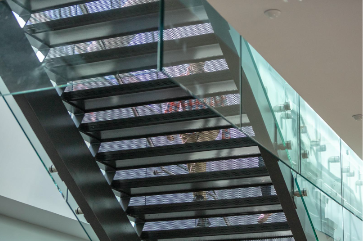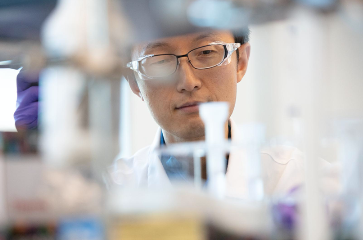Patritumab Deruxtecan Biologics License Application for Patients With Previously Treated Locally Advanced or Metastatic EGFR-Mutated Non-Small Cell Lung Cancer Voluntarily Withdrawn
May 29, 2025 7:00 am EDT
BASKING RIDGE, N.J. & RAHWAY, N.J., May 29, 2025 – The Biologics License Application (BLA) seeking accelerated approval in the U.S. for Daiichi Sankyo (TSE: 4568) and Merck’s (NYSE: MRK), known as MSD outside of the United States and Canada, patritumab deruxtecan (HER3-DXd), based on the HERTHENA-Lung01 Phase 2 trial for the treatment of adult patients with locally advanced or metastatic EGFR-mutated non-small cell lung cancer (NSCLC) previously treated with two or more systemic therapies, has been voluntarily withdrawn.
The decision to withdraw the BLA is based on topline overall survival (OS) results from the confirmatory HERTHENA-Lung02 Phase 3 trial where OS did not meet statistical significance, as well as discussions with the U.S. Food and Drug Administration. The decision is unrelated to the Complete Response Letter that was received in June 2024 and outlined findings pertaining to an inspection of a third-party manufacturing facility.
Patritumab deruxtecan is a specifically engineered HER3 directed DXd antibody drug conjugate (ADC) discovered by Daiichi Sankyo and being jointly developed by Daiichi Sankyo and Merck
Results from the HERTHENA-Lung02 Phase 3 trial, including previously reported statistically significant progression-free survival (PFS) along with topline OS results, will be presented during an oral presentation (#8506) at the 2025 American Society of Clinical Oncology (#ASCO25) Annual Meeting on Sunday, June 1, 2025.
HERTHENA-Lung02 is evaluating patritumab deruxtecan monotherapy versus doublet chemotherapy, consisting of platinum plus pemetrexed induction chemotherapy followed by pemetrexed maintenance chemotherapy, in patients with EGFR-mutated (exon 19 deletion or L858R mutated) advanced NSCLC after disease progression with a third generation EGFR tyrosine kinase inhibitor (TKI) treatment. Patients achieving tumor response will continue to receive patritumab deruxtecan or chemotherapy until disease progression, per investigator assessment.
“EGFR-mutated non-small cell lung cancer has proven to be difficult-to-treat in the second-line metastatic setting and beyond,” said Ken Takeshita, MD, global head, R&D, Daiichi Sankyo. “While we are disappointed with the overall survival results of HERTHENA-Lung02, we are conducting further biomarker analyses to better identify patients that may benefit from patritumab deruxtecan to guide our continued development in lung cancer. We remain confident in the broad development program of this HER3 directed antibody drug conjugate, which currently includes multiple clinical trials across 15 types of cancer.”
“Lung cancer is one of the leading causes of cancer-related deaths worldwide and these results are a reminder of how challenging it can be to treat these patients with EGFR-mutated non-small cell lung cancer in the second and later line settings,” said Eliav Barr, MD, senior vice president, head of global clinical development and chief medical officer, Merck Research Laboratories. “We would like to thank the patients, their families, and investigators for their participation in this study.”
The safety profile seen in HERTHENA-Lung02 was consistent with that observed for patritumab deruxtecan in previous lung cancer clinical trials, with no new safety signals identified.
About HERTHENA-Lung01
HERTHENA-Lung01 is a global, multicenter, open-label, two-arm Phase 2 trial evaluating the safety and efficacy of patritumab deruxtecan in patients with EGFR-mutated locally advanced or metastatic NSCLC following disease progression with an EGFR TKI and platinum-based chemotherapy. Patients were randomized 1:1 to receive 5.6 mg/kg (n=225) or an uptitration regimen (n=50). The uptitration arm was discontinued as the dose of 5.6 mg/kg of patritumab deruxtecan was selected following a risk-benefit analysis conducted from a separate Phase 1 trial assessing the doses in a similar patient population.
The primary endpoint of HERTHENA-Lung01 was objective response rate (ORR) as assessed by blinded independent central review (BICR). Secondary endpoints included duration of response, PFS, disease control rate, and time to response – all assessed by both BICR and investigator assessment – as well as investigator-assessed ORR, OS, safety and tolerability. The ORR data and additional results for key secondary endpoints of HERTHENA-Lung01 were published in the Journal of Clinical Oncology in September 2023.
HERTHENA-Lung01 enrolled 277 patients in Asia, Europe, North America and Oceania. For more information about the trial, visit ClinicalTrials.gov.
About HERTHENA-Lung02
HERTHENA-Lung02 is a global, multicenter, open-label, Phase 3 trial evaluating the efficacy and safety of patritumab deruxtecan (5.6 mg/kg every three weeks) monotherapy versus four cycles of doublet chemotherapy) pemetrexed and platinum chemotherapy) in patients with metastatic or locally advanced NSCLC with an EGFR-activating mutation (exon 19 deletion or L858R) after failure of third-generation (e.g., osimertinib, lazertinib, aumolertinib, alflutinib) EGFR TKI therapy. Patients in the chemotherapy arm without disease progression after four cycles of pemetrexed and platinum chemotherapy are able to continue treatment with maintenance pemetrexed with no restriction on the number of cycles.
The primary endpoint of HERTHENA-Lung02 is PFS as assessed by BICR. Secondary endpoints included OS, ORR, duration of response, clinical benefit rate, time to response, disease control rate, and safety. Patients enrolled in the study underwent brain imaging to allow for assessment of intracranial endpoints, including intracranial PFS as assessed by BICR.
HERTHENA-Lung02 enrolled 586 patients in Asia, Europe, North America and Oceania. For more information about the trial, visit ClinicalTrials.gov.
About EGFR-Mutated Non-Small Cell Lung Cancer
Nearly 2.5 million lung cancer cases were diagnosed globally in 2022. Lung cancer is the most common cancer and the leading cause of cancer-related deaths worldwide.9 NSCLC accounts for about 87% of all lung cancers1. Approximately 10% to 15% of patients with NSCLC in the U.S. and Europe, and 30% to 40% of patients in Asia have an EGFR mutation.3,4
NSCLC is diagnosed at an advanced stage in up to 70% of patients.2 For patients with tumors that have an EGFR mutation, the established first-line treatment in the metastatic setting includes EGFR-directed therapy with or without platinum-based chemotherapy.While these therapies have improved outcomes, most patients eventually experience disease progression and receive subsequent therapies.5,6,7,8
About HER3
HER3 is a member of the HER family of receptor tyrosine kinases.11 It is estimated that about 83% of primary NSCLC tumors and 90% of advanced EGFR-mutated tumors express HER3 after prior EGFR TKI treatment.12 HER3 is associated with poor treatment outcomes, including shorter relapse-free survival and significantly reduced survival.13,14 There is currently no HER3 directed therapy approved for the treatment of any cancer.
About Patritumab Deruxtecan
Patritumab deruxtecan (HER3-DXd) is an investigational HER3 directed ADC. Designed using Daiichi Sankyo’s proprietary DXd ADC Technology, patritumab deruxtecan is composed of a fully human anti-HER3 IgG1 monoclonal antibody attached to a number of topoisomerase I inhibitor payloads (an exatecan derivative, DXd) via tetrapeptide-based cleavable linkers.
About the Patritumab Deruxtecan Clinical Development Program
A comprehensive global clinical development program is underway evaluating the efficacy and safety of patritumab deruxtecan across cancers. Trials in combination with other anticancer treatments are also underway.
About the Daiichi Sankyo and Merck collaboration
Daiichi Sankyo and Merck entered into a global collaboration in October 2023 to jointly develop and commercialize patritumab deruxtecan (HER3-DXd), ifinatamab deruxtecan (I-DXd) and raludotatug deruxtecan (R-DXd), except in Japan where Daiichi Sankyo will maintain exclusive rights. Daiichi Sankyo will be solely responsible for manufacturing and supply. In August 2024, the global co-development and co-commercialization agreement was expanded to include gocatamig (MK-6070/DS3280), which the companies will jointly develop and commercialize worldwide, except in Japan where Merck will maintain exclusive rights. Merck will be solely responsible for manufacturing and supply for gocatamig.
About the ADC Portfolio of Daiichi Sankyo
The Daiichi Sankyo ADC portfolio consists of seven ADCs in clinical development crafted from two distinct ADC technology platforms discovered in-house by Daiichi Sankyo.
The ADC platform furthest in clinical development is Daiichi Sankyo’s DXd ADC Technology where each ADC consists of a monoclonal antibody attached to a number of topoisomerase I inhibitor payloads (an exatecan derivative, DXd) via tetrapeptide-based cleavable linkers. The DXd ADC portfolio currently consists of ENHERTU®, a HER2 directed ADC, and DATROWAY®, a TROP2 directed ADC, which are being jointly developed and commercialized globally with AstraZeneca. Patritumab deruxtecan (HER3-DXd), a HER3 directed ADC, ifinatamab deruxtecan (I-DXd), a B7-H3 directed ADC, and raludotatug deruxtecan (R-DXd), a CDH6 directed ADC, are being jointly developed and commercialized globally with Merck. DS-3939, a TA-MUC1 directed ADC, is being developed by Daiichi Sankyo.
The second Daiichi Sankyo ADC platform consists of a monoclonal antibody attached to a modified pyrrolobenzodiazepine (PBD) payload. DS-9606, a CLDN6 directed PBD ADC, is the first of several planned ADCs in clinical development utilizing this platform.
Ifinatamab deruxtecan, patritumab deruxtecan, raludotatug deruxtecan, DS-3939 and DS-9606 are investigational medicines that have not been approved for any indication in any country. Safety and efficacy have not been established.
About Daiichi Sankyo
Daiichi Sankyo is an innovative global healthcare company contributing to the sustainable development of society that discovers, develops and delivers new standards of care to enrich the quality of life around the world. With more than 120 years of experience, Daiichi Sankyo leverages its world-class science and technology to create new modalities and innovative medicines for people with cancer, cardiovascular and other diseases with high unmet medical needs. For more information, please visit www.daiichisankyo.com.
Merck’s Focus on Cancer
Every day, we follow the science as we work to discover innovations that can help patients, no matter what stage of cancer they have. As a leading oncology company, we are pursuing research where scientific opportunity and medical need converge, underpinned by our diverse pipeline of more than 25 novel mechanisms. With one of the largest clinical development programs across more than 30 tumor types, we strive to advance breakthrough science that will shape the future of oncology. By addressing barriers to clinical trial participation, screening and treatment, we work with urgency to reduce disparities and help ensure patients have access to high-quality cancer care. Our unwavering commitment is what will bring us closer to our goal of bringing life to more patients with cancer. For more information, visit https://www.merck.com/research/oncology.
About Merck
At Merck, known as MSD outside of the United States and Canada, we are unified around our purpose: We use the power of leading-edge science to save and improve lives around the world. For more than 130 years, we have brought hope to humanity through the development of important medicines and vaccines. We aspire to be the premier research-intensive biopharmaceutical company in the world – and today, we are at the forefront of research to deliver innovative health solutions that advance the prevention and treatment of diseases in people and animals. We foster a diverse and inclusive global workforce and operate responsibly every day to enable a safe, sustainable and healthy future for all people and communities. For more information, visit www.merck.com and connect with us on X (formerly Twitter), Facebook, Instagram, YouTube and LinkedIn.
Forward-Looking Statement of Merck & Co., Inc., Rahway, N.J., USA
This news release of Merck & Co., Inc., Rahway, N.J., USA (the “company”) includes “forward-looking statements” within the meaning of the safe harbor provisions of the U.S. Private Securities Litigation Reform Act of 1995. These statements are based upon the current beliefs and expectations of the company’s management and are subject to significant risks and uncertainties. There can be no guarantees with respect to pipeline candidates that the candidates will receive the necessary regulatory approvals or that they will prove to be commercially successful. If underlying assumptions prove inaccurate or risks or uncertainties materialize, actual results may differ materially from those set forth in the forward-looking statements.
Risks and uncertainties include but are not limited to, general industry conditions and competition; general economic factors, including interest rate and currency exchange rate fluctuations; the impact of pharmaceutical industry regulation and health care legislation in the United States and internationally; global trends toward health care cost containment; technological advances, new products and patents attained by competitors; challenges inherent in new product development, including obtaining regulatory approval; the company’s ability to accurately predict future market conditions; manufacturing difficulties or delays; financial instability of international economies and sovereign risk; dependence on the effectiveness of the company’s patents and other protections for innovative products; and the exposure to litigation, including patent litigation, and/or regulatory actions.
The company undertakes no obligation to publicly update any forward-looking statement, whether as a result of new information, future events or otherwise. Additional factors that could cause results to differ materially from those described in the forward-looking statements can be found in the company’s Annual Report on Form 10-K for the year ended December 31, 2024 and the company’s other filings with the Securities and Exchange Commission (SEC) available at the SEC’s Internet site (www.sec.gov).
###
Media Contacts: Merck
Julie Cunningham (617) 519-6264 julie.cunningham@merck.com
Michael McArdle (908) 447-9453 michael.mcardle@merck.com
Daiichi Sankyo
Global/US Media
Jennifer Brennan (908) 900-3183 jennifer.brennan@daiichisankyo.com
Japan Media:
DS-PR@daiichisankyo.co.jp
Investor Contacts: Merck
Peter Dannenbaum (732) 594-1579 peter.dannenbaum@merck.com
Steven Graziano (732) 594-1583 steven.graziano@merck.com
Daiichi Sankyo DaiichiSankyoIR_jp@daiichisankyo.com
References:
- American Cancer Society. Key Statistics for Lung Cancer. Accessed April 2025.
- Guo H, et al. Front Oncol. 2021; 11: 761042.
- Szumera-Ciećkiewicz A, et al. Int J Clin Exp Pathol. 2013;6(12): 2800-2812.
- Ellison G, et al. J Clin Pathol. 2013;66(2):79-89.
- Chen R, et al. J Hematol Oncol. 2020:13(1):58.
- Majeed U, et al. J Hematol Oncol. 2021;14(1):108.
- Morgillo F, et al. ESMO Open. 2016;1:e000060.
- Han B, et al. Onco Targets Ther. 2018;11:2121-9
- World Health Organization. International Agency for Research on Cancer. Lung Fact Sheet. Accessed February 2025.
- American Cancer Society. Targeted Drug Therapy for Non-Small Cell Lung Cancer. Accessed March 2025.
- Mishra R, et al. Onco Rev. 2018; 12(355):45-62. 11
- Scharpenseel H, et al. Scientific Reports. 2019; 9:7406. 12
- Gandullo-Sánchez L et al. J Exp Clin Cancer Res. 2022; 41:310. 13
- Yu H.A., et al. Annals of Oncology. 2024; 35(5): P437-447. 14



